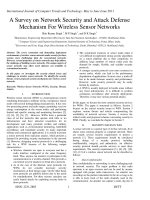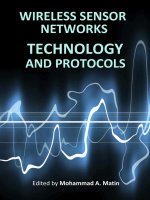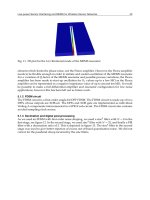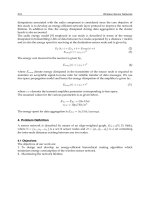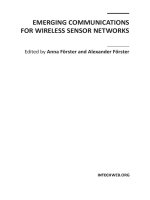Wireless Sensor Networks – Technology and Protocols pptx
Bạn đang xem bản rút gọn của tài liệu. Xem và tải ngay bản đầy đủ của tài liệu tại đây (10.61 MB, 319 trang )
WIRELESS SENSOR
TECHNOLOGY
AND PROTOCOLS
NETWORKS
Edited by Mohammad A. Matin
WIRELESS SENSOR
NETWORKS –
TECHNOLOGY
AND PROTOCOLS
Edited by Mohammad A. Matin
Wireless Sensor Networks – Technology and Protocols
Edited by Mohammad A. Matin
Contributors
M.A. Matin, M.M. Islam, Akshaye Dhawan, S. Chinnappen-Rimer, G. P. Hancke,
Wuyungerile Li, Ziyuan Pan, Takashi Watanabe, Jan Nikodem, Marek Woda, Maciej Nikodem,
Mohamed M. A. Azim, Aly M. Al-Semary, Alexander Klein, Elias Yaacoub, Adnan Abu-Dayya,
Omar M. Sheikh, Samy A. Mahmoud, Gustavo S. Quirino, Admilson R. L. Ribeiro,
Edward David Moreno, A. R. Naseer, Shuai Li, Yangming Li
Published by InTech
Janeza Trdine 9, 51000 Rijeka, Croatia
Copyright © 2012 InTech
All chapters are Open Access distributed under the Creative Commons Attribution 3.0 license,
which allows users to download, copy and build upon published articles even for commercial
purposes, as long as the author and publisher are properly credited, which ensures maximum
dissemination and a wider impact of our publications. After this work has been published by
InTech, authors have the right to republish it, in whole or part, in any publication of which they
are the author, and to make other personal use of the work. Any republication, referencing or
personal use of the work must explicitly identify the original source.
Notice
Statements and opinions expressed in the chapters are these of the individual contributors and
not necessarily those of the editors or publisher. No responsibility is accepted for the accuracy
of information contained in the published chapters. The publisher assumes no responsibility for
any damage or injury to persons or property arising out of the use of any materials,
instructions, methods or ideas contained in the book.
Publishing Process Manager Marijan Polic
Typesetting InTech Prepress, Novi Sad
Cover InTech Design Team
First published September, 2012
Printed in Croatia
A free online edition of this book is available at www.intechopen.com
Additional hard copies can be obtained from
Wireless Sensor Networks – Technology and Protocols, Edited by Mohammad A. Matin
p. cm.
ISBN 978-953-51-0735-4
Contents
Preface IX
Section 1 Basic Concepts & Energy Efficient
Design Principles 1
Chapter 1 Overview of Wireless Sensor Network 3
M.A. Matin and M.M. Islam
Chapter 2 Maximum Lifetime Scheduling
in Wireless Sensor Networks 25
Akshaye Dhawan
Chapter 3 Calculation of an Optimum Mobile
Sink Path in a Wireless Sensor Network 49
S. Chinnappen-Rimer and G. P. Hancke
Chapter 4 Tradeoffs Among Delay, Energy
and Accuracy of Data Aggregation
for Multi-View Multi-Robot Sensor Networks 71
Wuyungerile Li, Ziyuan Pan and Takashi Watanabe
Chapter 5 Spatial Communication Activity
in Wireless Sensor Networks Based
on Migrated Base Stations 99
Jan Nikodem, Marek Woda and Maciej Nikodem
Chapter 6 Assessing the Vulnerabilities of Mission-Critical
Wireless Sensor Networks 117
Mohamed M. A. Azim and Aly M. Al-Semary
Section 2 MAC Protocols 137
Chapter 7 Preamble-Based Medium Access
in Wireless Sensor Networks 139
Alexander Klein
VI Contents
Section 3 Routing Protocols 163
Chapter 8 Multihop Routing for Energy Efficiency
in Wireless Sensor Networks 165
Elias Yaacoub and Adnan Abu-Dayya
Chapter 9 Cross-Layer Design for Smart Routing
in Wireless Sensor Networks 189
Omar M. Sheikh and Samy A. Mahmoud
Section 4 Security Mechanisms 215
Chapter 10 Asymmetric Encryption in Wireless Sensor Networks 217
Gustavo S. Quirino, Admilson R. L. Ribeiro
and Edward David Moreno
Chapter 11 Reputation System Based Trust-Enabled
Routing for Wireless Sensor Networks 233
A. R. Naseer
Section 5 Localization & Positioning 287
Chapter 12 Distributed Range-Free Localization of Wireless Sensor
Networks via Nonlinear Dynamics 289
Shuai Li and Yangming Li
Preface
Wireless Sensor Networks hold the promise of delivering a smart communication
paradigm which enables setting up an intelligent network capable of handling
applications that evolve from user requirements. With the recent technological
advances of wireless sensor network, it is becoming an integral part of our lives.
However, due to the nature of wireless sensor networks, researchers face new
challenges related to the design of algorithms and protocols. This book identifies the
research that needs to be conducted on a number of levels to design and assess the
deployment of wireless sensor networks. It highlights the current state of the
technology, which puts the readers in good pace to be able to understand more
advanced research and make a contribution in this field for themselves.
Chapter 1 has approached to draw the overall concept of a Wireless Sensor network so
that the general readers can be able to easily grasp some ideas in this area.
Chapter 2 examines the problem of maximizing the duration of time for which the
network meets its coverage objective. Since networks are very dense, only a subset of
sensors need to be in “sense” or “on” mode at any given time to meet the coverage
objective, while others can go into a power conserving “sleep” mode. This active set of
sensors is known as a cover. The lifetime of the network can be extended by shuffling
the cover set over time.
Chapter 3 presents the optimum path calculation for a mobile sink and ensures
equitable usage of all nodes to transfer an event message so that no specific set of
nodes is overloaded with the task of routing event messages to the sink.
Chapter 4 discusses data aggregation in wireless multi-view multi-robot sensor
networks and introduces a User Dependent Multi-view Video Transmission (UDMVT)
scheme to decrease the bit rate of multi view video transmission, thus reduces
bandwidth requirement.
Chapter 5 deals with the base station migration feature which allows for reduction a
number of base stations along with the dynamic network load distribution adapted to
a current situation.
X Preface
Chapter 6 investigates the impact of region-based faults on the connectivity of wireless
networks. It also introduces a new model for a worst-case cut (partition) due to failure
regions. The presented model takes into consideration the physical correlation among
the locations of the network nodes and the possible priority of some nodes over the
others. Based on this model, the location of a disaster can be identified.
Chapter 7 presents Preamble sampling protocol which is the ideal candidate for
energy-constraint WSNs.
Preamble sampling can be integrated in many ways to schedule the medium access
and achieve the desired access characteristics.
Chapter 8 outlines cooperative data transmission in wireless sensor networks with the
objective of energy minimization. The problem is formulated into an optimization
problem, and efficient suboptimal methods are presented for the two scenarios: the
multihop case where the maximum number of hops is allowed and the clustering case
where sensors are grouped into cooperating clusters, each headed by a cluster head in
charge of the communication with the base station. Practical implementation aspects
are also discussed.
Chapter 9 covers the design of the smart routing protocol for wireless sensor networks
(WSNs). This protocol is based on performance measure and energy optimization
using cross-layer considerations of the protocol stack. Smart routing selects candidate
nodes that are best able to satisfy both performance and energy conservation
requirements given network conditions. It analyzes application requirements,
available network routes, transmission channel quality and remaining energy
distribution in the network prior to making a resource allocation decision.
Chapter 10 presents different cryptographic algorithms for WSN. The algorithm
Multivariate Quadratic Quasigroup (MQQ) was discovered recently and showed
significant performance when compared to RSA and Elliptic Curve Cryptography
(ECC). This algorithm is post-quantum, and may even be a good solution when the
quantum computation is standardized.
Chapter 11 describes reputation system based Trust-enabled Routing approach –
Geographic, Energy and Trust Aware Routing (GETAR). A research-guiding approach
is also presented to the reader that analyzes and criticizes different techniques and
solution directions for the Reputation system based Trust-enabled secure routing
problem in wireless sensor network.
Chapter 12 explains the importance of designing localization hardware and
localization algorithms in the development of a WSN system and formulates the
range-free localization problem as two different optimization problems, each of which
corresponds to a dynamic model. The models are described by nonlinear ordinary
differential equations (ODEs). The state value of the ODEs converges to the expected
Preface XI
position estimation of sensors. Both of the two models find feasible solutions to the
formulated optimization problem.
It is believed that the students who seek to learn the latest developments in wireless
sensor network technologies will need this book.
Mohammad A. Matin
Institut Teknologi Brunei,
Brunei Darussalam
Section 1
Basic Concepts &
Energy Efficient Design Principles
Chapter 1
Overview of Wireless Sensor Network
M.A. Matin and M.M. Islam
Additional information is available at the end of the chapter
1. Introduction
Wireless Sensor Networks (WSNs) can be defined as a self-configured and infrastructure-
less wireless networks to monitor physical or environmental conditions, such as
temperature, sound, vibration, pressure, motion or pollutants and to cooperatively pass
their data through the network to a main location or sink where the data can be observed
and analysed. A sink or base station acts like an interface between users and the network.
One can retrieve required information from the network by injecting queries and gathering
results from the sink. Typically a wireless sensor network contains hundreds of thousands
of sensor nodes. The sensor nodes can communicate among themselves using radio signals.
A wireless sensor node is equipped with sensing and computing devices, radio transceivers
and power components. The individual nodes in a wireless sensor network (WSN) are
inherently resource constrained: they have limited processing speed, storage capacity, and
communication bandwidth. After the sensor nodes are deployed, they are responsible for
self-organizing an appropriate network infrastructure often with multi-hop communication
with them. Then the onboard sensors start collecting information of interest. Wireless sensor
devices also respond to queries sent from a “control site” to perform specific instructions or
provide sensing samples. The working mode of the sensor nodes may be either continuous
or event driven. Global Positioning System (GPS) and local positioning algorithms can be
used to obtain location and positioning information. Wireless sensor devices can be
equipped with actuators to “act” upon certain conditions. These networks are sometimes
more specifically referred as Wireless Sensor and Actuator Networks as described in
(Akkaya et al., 2005).
Wireless sensor networks (WSNs) enable new applications and require non-conventional
paradigms for protocol design due to several constraints. Owing to the requirement for low
device complexity together with low energy consumption (i.e. long network lifetime), a
proper balance between communication and signal/data processing capabilities must be
found. This motivates a huge effort in research activities, standardization process, and
Wireless Sensor Networks – Technology and Protocols
4
industrial investments on this field since the last decade (Chiara et. al. 2009). At present
time, most of the research on WSNs has concentrated on the design of energy- and
computationally efficient algorithms and protocols, and the application domain has been
restricted to simple data-oriented monitoring and reporting applications (Labrador et. al.
2009). The authors in (Chen et al., 2011) propose a Cable Mode Transition (CMT) algorithm,
which determines the minimal number of active sensors to maintain K-coverage of a terrain
as well as K-connectivity of the network. Specifically, it allocates periods of inactivity for
cable sensors without affecting the coverage and connectivity requirements of the network
based only on local information. In (Cheng et al., 2011), a delay-aware data collection
network structure for wireless sensor networks is proposed. The objective of the proposed
network structure is to minimize delays in the data collection processes of wireless sensor
networks which extends the lifetime of the network. In (Matin et al., 2011), the authors have
considered relay nodes to mitigate the network geometric deficiencies and used Particle
Swarm Optimization (PSO) based algorithms to locate the optimal sink location with respect
to those relay nodes to overcome the lifetime challenge. Energy efficient communication has
also been addressed in (Paul et al., 2011; Fabbri et al. 2009). In (Paul et al., 2011), the authors
proposed a geometrical solution for locating the optimum sink placement for maximizing
the network lifetime. Most of the time, the research on wireless sensor networks have
considered homogeneous sensor nodes. But nowadays researchers have focused on
heterogeneous sensor networks where the sensor nodes are unlike to each other in terms of
their energy. In (Han et al., 2010), the authors addresses the problem of deploying relay
nodes to provide fault tolerance with higher network connectivity in heterogeneous wireless
sensor networks, where sensor nodes possess different transmission radii. New network
architectures with heterogeneous devices and the recent advancement in this technology
eliminate the current limitations and expand the spectrum of possible applications for WSNs
considerably and all these are changing very rapidly.
Figure 1. A typical Wireless Sensor Network
2. Applications of wireless sensor network
Wireless sensor networks have gained considerable popularity due to their flexibility in
solving problems in different application domains and have the potential to change our lives
Overview of Wireless Sensor Network
5
in many different ways. WSNs have been successfully applied in various application
domains (Akyildiz et al. 2002; Bharathidasan et al., 2001), (Yick et al., 2008; Boukerche, 2009),
(Sohraby et al., 2007), and ( Chiara et al., 2009;Verdone et al., 2008), such as:
Military applications: Wireless sensor networks be likely an integral part of military
command, control, communications, computing, intelligence, battlefield surveillance,
reconnaissance and targeting systems.
Area monitoring: In area monitoring, the sensor nodes are deployed over a region where
some phenomenon is to be monitored. When the sensors detect the event being monitored
(heat, pressure etc), the event is reported to one of the base stations, which then takes
appropriate action.
Transportation: Real-time traffic information is being collected by WSNs to later feed
transportation models and alert drivers of congestion and traffic problems.
Health applications: Some of the health applications for sensor networks are supporting
interfaces for the disabled, integrated patient monitoring, diagnostics, and drug
administration in hospitals, tele-monitoring of human physiological data, and tracking &
monitoring doctors or patients inside a hospital.
Environmental sensing: The term Environmental Sensor Networks has developed to cover
many applications of WSNs to earth science research. This includes sensing volcanoes,
oceans, glaciers, forests etc. Some other major areas are listed below:
Air pollution monitoring
Forest fires detection
Greenhouse monitoring
Landslide detection
Structural monitoring: Wireless sensors can be utilized to monitor the movement within
buildings and infrastructure such as bridges, flyovers, embankments, tunnels etc enabling
Engineering practices to monitor assets remotely with out the need for costly site visits.
Industrial monitoring: Wireless sensor networks have been developed for machinery
condition-based maintenance (CBM) as they offer significant cost savings and enable new
functionalities. In wired systems, the installation of enough sensors is often limited by the
cost of wiring.
Agricultural sector: using a wireless network frees the farmer from the maintenance of
wiring in a difficult environment. Irrigation automation enables more efficient water use
and reduces waste.
3. Design issues of a wireless sensor network
There are a lot of challenges placed by the deployment of sensor networks which are a
superset of those found in wireless ad hoc networks. Sensor nodes communicate over
wireless, lossy lines with no infrastructure. An additional challenge is related to the limited,
Wireless Sensor Networks – Technology and Protocols
6
usually non-renewable energy supply of the sensor nodes. In order to maximize the lifetime
of the network, the protocols need to be designed from the beginning with the objective of
efficient management of the energy resources (Akyildiz et al., 2002). Wireless Sensor
Network Design issues are mentioned in (Akkaya et al., 2005), (Akyildizet al., 2002),
(SensorSim; Tossim, Younis et al., 2004), (Pan et al., 2003) and different possible platforms
for simulation and testing of routing protocols for WSNs are discussed in ( NS-2, Zeng et al.,
1998, SensorSim, Tossiim ). Let us now discuss the individual design issues in greater detail.
Fault Tolerance: Sensor nodes are vulnerable and frequently deployed in dangerous
environment. Nodes can fail due to hardware problems or physical damage or by
exhausting their energy supply. We expect the node failures to be much higher than the one
normally considered in wired or infrastructure-based wireless networks. The protocols
deployed in a sensor network should be able to detect these failures as soon as possible and
be robust enough to handle a relatively large number of failures while maintaining the
overall functionality of the network. This is especially relevant to the routing protocol
design, which has to ensure that alternate paths are available for rerouting of the packets.
Different deployment environments pose different fault tolerance requirements.
Scalability: Sensor networks vary in scale from several nodes to potentially several hundred
thousand. In addition, the deployment density is also variable. For collecting high-
resolution data, the node density might reach the level where a node has several thousand
neighbours in their transmission range. The protocols deployed in sensor networks need to
be scalable to these levels and be able to maintain adequate performance.
Production Costs: Because many deployment models consider the sensor nodes to be
disposable devices, sensor networks can compete with traditional information gathering
approaches only if the individual sensor nodes can be produced very cheaply. The target
price envisioned for a sensor node should ideally be less than $1.
Hardware Constraints: At minimum, every sensor node needs to have a sensing unit, a
processing unit, a transmission unit, and a power supply. Optionally, the nodes may have
several built-in sensors or additional devices such as a localization system to enable
location-aware routing. However, every additional functionality comes with additional cost
and increases the power consumption and physical size of the node. Thus, additional
functionality needs to be always balanced against cost and low-power requirements.
Sensor Network Topology: Although WSNs have evolved in many aspects, they continue to
be networks with constrained resources in terms of energy, computing power, memory, and
communications capabilities. Of these constraints, energy consumption is of paramount
importance, which is demonstrated by the large number of algorithms, techniques, and
protocols that have been developed to save energy, and thereby extend the lifetime of the
network. Topology Maintenance is one of the most important issues researched to reduce
energy consumption in wireless sensor networks.
Transmission Media: The communication between the nodes is normally implemented
using radio communication over the popular ISM bands. However, some sensor networks
Overview of Wireless Sensor Network
7
use optical or infrared communication, with the latter having the advantage of being robust
and virtually interference free.
Power Consumption: As we have already seen, many of the challenges of sensor networks
revolve around the limited power resources. The size of the nodes limits the size of the
battery. The software and hardware design needs to carefully consider the issues of efficient
energy use. For instance, data compression might reduce the amount of energy used for
radio transmission, but uses additional energy for computation and/or filtering. The energy
policy also depends on the application; in some applications, it might be acceptable to turn
off a subset of nodes in order to conserve energy while other applications require all nodes
operating simultaneously.
4. Structure of a wireless sensor network
Structure of a Wireless Sensor Network includes different topologies for radio
communications networks. A short discussion of the network topologies that apply to
wireless sensor networks are outlined below:
4.1. Star network (single point-to-multipoint) (Wilson, 2005)
A star network is a communications topology where a single base station can send and/or
receive a message to a number of remote nodes. The remote nodes are not permitted to send
messages to each other. The advantage of this type of network for wireless sensor networks
includes simplicity, ability to keep the remote node’s power consumption to a minimum. It
also allows low latency communications between the remote node and the base station. The
disadvantage of such a network is that the base station must be within radio transmission
range of all the individual nodes and is not as robust as other networks due to its
dependency on a single node to manage the network.
Figure 2. A Star network topology
Wireless Sensor Networks – Technology and Protocols
8
4.2. Mesh network (Wilson, 2005)
A mesh network allows transmitting data to one node to other node in the network that is
within its radio transmission range. This allows for what is known as multi-hop
communications, that is, if a node wants to send a message to another node that is out of
radio communications range, it can use an intermediate node to forward the message to the
desired node. This network topology has the advantage of redundancy and scalability. If an
individual node fails, a remote node still can communicate to any other node in its range,
which in turn, can forward the message to the desired location. In addition, the range of the
network is not necessarily limited by the range in between single nodes; it can simply be
extended by adding more nodes to the system. The disadvantage of this type of network is
in power consumption for the nodes that implement the multi-hop communications are
generally higher than for the nodes that don’t have this capability, often limiting the battery
life. Additionally, as the number of communication hops to a destination increases, the time
to deliver the message also increases, especially if low power operation of the nodes is a
requirement.
Figure 3. A Mesh network topology
4.3. Hybrid star – Mesh network (Wilson, 2005)
A hybrid between the star and mesh network provides a robust and versatile
communications network, while maintaining the ability to keep the wireless sensor nodes
power consumption to a minimum. In this network topology, the sensor nodes with lowest
power are not enabled with the ability to forward messages. This allows for minimal power
consumption to be maintained. However, other nodes on the network are enabled with
multi-hop capability, allowing them to forward messages from the low power nodes to
other nodes on the network. Generally, the nodes with the multi-hop capability are higher
power, and if possible, are often plugged into the electrical mains line. This is the topology
implemented by the up and coming mesh networking standard known as ZigBee.
Overview of Wireless Sensor Network
9
Figure 4. A Hybrid Star – Mesh network topology
5. Structure of a wireless sensor node
A sensor node is made up of four basic components such as sensing unit, processing unit,
transceiver unit and a power unit which is shown in Fig. 5. It also has application dependent
additional components such as a location finding system, a power generator and a
mobilizer. Sensing units are usually composed of two subunits: sensors and analogue to
digital converters (ADCs) (Akyildiz et al., 2002). The analogue signals produced by the
sensors are converted to digital signals by the ADC, and then fed into the processing unit.
The processing unit is generally associated with a small storage unit and it can manage
the procedures that make the sensor node collaborate with the other nodes to carry out
the assigned sensing tasks. A transceiver unit connects the node to the network. One of
the most important components of a sensor node is the power unit. Power units can be
supported by a power scavenging unit such as solar cells. The other subunits, of the node
are application dependent.
A functional block diagram of a versatile wireless sensing node is provided in Fig. 6.
Modular design approach provides a flexible and versatile platform to address the needs of
a wide variety of applications. For example, depending on the sensors to be deployed, the
signal conditioning block can be re-programmed or replaced. This allows for a wide variety
Wireless Sensor Networks – Technology and Protocols
10
of different sensors to be used with the wireless sensing node. Similarly, the radio link may
be swapped out as required for a given applications’ wireless range requirement and the
need for bidirectional communications.
Figure 5. The components of a sensor node
Figure 6. Functional block diagram of a sensor node
Using flash memory, the remote nodes acquire data on command from a base station, or by
an event sensed by one or more inputs to the node. Moreover, the embedded firmware can
be upgraded through the wireless network in the field.
The microprocessor has a number of functions including:
Overview of Wireless Sensor Network
11
Managing data collection from the sensors
performing power management functions
interfacing the sensor data to the physical radio layer
managing the radio network protocol
A key aspect of any wireless sensing node is to minimize the power consumed by the
system. Usually, the radio subsystem requires the largest amount of power. Therefore, data
is sent over the radio network only when it is required. An algorithm is to be loaded into the
node to determine when to send data based on the sensed event. Furthermore, it is
important to minimize the power consumed by the sensor itself. Therefore, the hardware
should be designed to allow the microprocessor to judiciously control power to the radio,
sensor, and sensor signal conditioner (Akyildiz et al., 2002).
6. Communication structure of a wireless sensor network
The sensor nodes are usually scattered in a sensor field as shown in Fig. 1. Each of these
scattered sensor nodes has the capabilities to collect data and route data back to the sink and
the end users. Data are routed back to the end user by a multi-hop infrastructure-less
architecture through the sink as shown in Fig. 1. The sink may communicate with the task
manager node via Internet or Satellite.
Figure 7. Wireless Sensor Network protocol stack
The protocol stack used by the sink and the sensor nodes is given in Fig. 7. This protocol
stack combines power and routing awareness, integrates data with networking protocols,
communicates power efficiently through the wireless medium and promotes cooperative
efforts of sensor nodes. The protocol stack consists of the application layer, transport layer,
Wireless Sensor Networks – Technology and Protocols
12
network layer, data link layer, physical layer, power management plane, mobility
management plane, and task management plane (Akyildiz et al., 2002). Different types of
application software can be built and used on the application layer depending on the
sensing tasks. This layer makes hardware and software of the lowest layer transparent to the
end-user. The transport layer helps to maintain the flow of data if the sensor networks
application requires it. The network layer takes care of routing the data supplied by the
transport layer, specific multi-hop wireless routing protocols between sensor nodes and
sink. The data link layer is responsible for multiplexing of data streams, frame detection,
Media Access Control (MAC) and error control. Since the environment is noisy and sensor
nodes can be mobile, the MAC protocol must be power aware and able to minimize collision
with neighbours’ broadcast. The physical layer addresses the needs of a simple but robust
modulation, frequency selection, data encryption, transmission and receiving techniques.
In addition, the power, mobility, and task management planes monitor the power,
movement, and task distribution among the sensor nodes. These planes help the sensor
nodes coordinate the sensing task and lower the overall energy consumption.
7. Energy consumption issues in wireless sensor network
Energy consumption is the most important factor to determine the life of a sensor network
because usually sensor nodes are driven by battery. Sometimes energy optimization is more
complicated in sensor networks because it involved not only reduction of energy
consumption but also prolonging the life of the network as much as possible. The
optimization can be done by having energy awareness in every aspect of design and
operation. This ensures that energy awareness is also incorporated into groups of
communicating sensor nodes and the entire network and not only in the individual nodes
(Bharathidasan et al. 2001).
A sensor node usually consists of four sub-systems (Bharathidasan et al. 2001):
a computing subsystem : It consists of a microprocessor(microcontroller unit, MCU)
which is responsible for the control of the sensors and implementation of
communication protocols. MCUs usually operate under various modes for power
management purposes. As these operating modes involves consumption of power, the
energy consumption levels of the various modes should be considered while looking at
the battery lifetime of each node.
a communication subsystem: It consists of a short range radio which communicate with
neighboring nodes and the outside world. Radios can operate under the different
modes. It is important to completely shut down the radio rather than putting it in the
Idle mode when it is not transmitting or receiving for saving power.
a sensing subsystem : It consists of a group of sensors and actuators and link the node
to the outside world. Energy consumption can be reduced by using low power
components and saving power at the cost of performance which is not required.
Overview of Wireless Sensor Network
13
a power supply subsystem : It consists of a battery which supplies power to the node. It
should be seen that the amount of power drawn from a battery is checked because if
high current is drawn from a battery for a long time, the battery will die faster even
though it could have gone on for a longer time. Usually the rated current capacity of a
battery being used for a sensor node is less than the minimum energy consumption.
The lifetime of a battery can be increased by reducing the current drastically or even
turning it off often.
To minimize the overall energy consumption of the sensor network, different types of
protocols and algorithms have been studied so far all over the world. The lifetime of a
sensor network can be increased significantly if the operating system, the application layer
and the network protocols are designed to be energy aware. These protocols and algorithms
have to be aware of the hardware and able to use special features of the micro-processors
and transceivers to minimize the sensor node’s energy consumption. This may push toward
a custom solution for different types of sensor node design. Different types of sensor nodes
deployed also lead to different types of sensor networks. This may also lead to the different
types of collaborative algorithms in wireless sensor networks arena.
8. Protocols & algorithms of wireless sensor network
In WSN, the main task of a sensor node is to sense data and sends it to the base station in
multi hop environment for which routing path is essential. For computing the routing path
from the source node to the base station there is huge numbers of proposed routing
protocols exist (Sharma et al., 2011). The design of routing protocols for WSNs must
consider the power and resource limitations of the network nodes, the time-varying quality
of the wireless channel, and the possibility for packet loss and delay. To address these
design requirements, several routing strategies for WSNs have been proposed in (Labrador
et al., 2009), (Akkaya et al., 2005), ( Akyildiz et al. 2002), (Boukerche, 2009, Al-karaki et al.,
2004, Pan et al., 2003) and (Waharte et al., 2006).
The first class of routing protocols adopts a flat network architecture in which all nodes are
considered peers. Flat network architecture has several advantages, including minimal
overhead to maintain the infrastructure and the potential for the discovery of multiple
routes between communicating nodes for fault tolerance.
A second class of routing protocols imposes a structure on the network to achieve energy
efficiency, stability, and scalability. In this class of protocols, network nodes are organized in
clusters in which a node with higher residual energy, for example, assumes the role of a
cluster head. The cluster head is responsible for coordinating activities within the cluster
and forwarding information between clusters. Clustering has potential to reduce energy
consumption and extend the lifetime of the network.
A third class of routing protocols uses a data-centric approach to disseminate interest within
the network. The approach uses attribute-based naming, whereby a source node queries an
attribute for the phenomenon rather than an individual sensor node. The interest
Wireless Sensor Networks – Technology and Protocols
14
dissemination is achieved by assigning tasks to sensor nodes and expressing queries to
relative to specific attributes. Different strategies can be used to communicate interests to the
sensor nodes, including broadcasting, attribute-based multicasting, geo-casting, and any
casting.
A fourth class of routing protocols uses location to address a sensor node. Location-based
routing is useful in applications where the position of the node within the geographical
coverage of the network is relevant to the query issued by the source node. Such a query
may specify a specific area where a phenomenon of interest may occur or the vicinity to a
specific point in the network environment.
In the rest of this section we discuss some of the major routing protocols and algorithms to
deal with the energy conservation issue in the literatures.
1. Flooding: Flooding is a common technique frequently used for path discovery and
information dissemination in wired and wireless ad hoc networks which has been
discussed in (Akyildiz et al., 2002). The routing strategy of flooding is simple and does
not rely on costly network topology maintenance and complex route discovery
algorithms. Flooding uses a reactive approach whereby each node receiving a data or
control packet sends the packet to all its neighbors. After transmission, a packet follows
all possible paths. Unless the network is disconnected, the packet will eventually reach
its destination. Furthermore, as the network topology changes, the packet transmitted
follows the new routes. Fig. 8 illustrates the concept of flooding in data communications
network. As shown in the figure, flooding in its simplest form may cause packets to be
replicated indefinitely by network nodes.
Figure 8. Flooding in data communication networks

